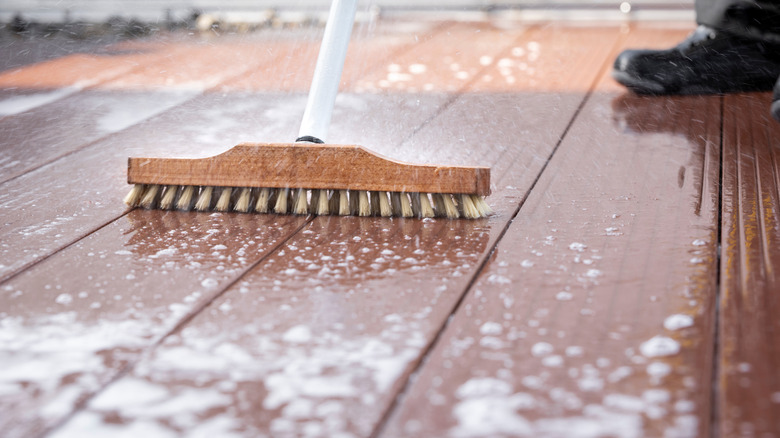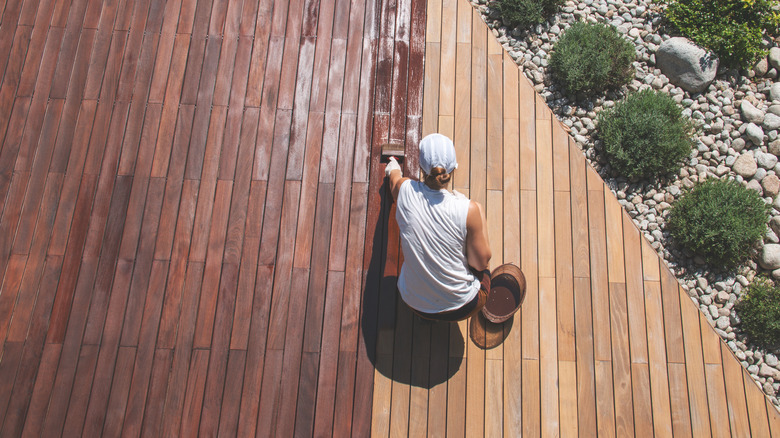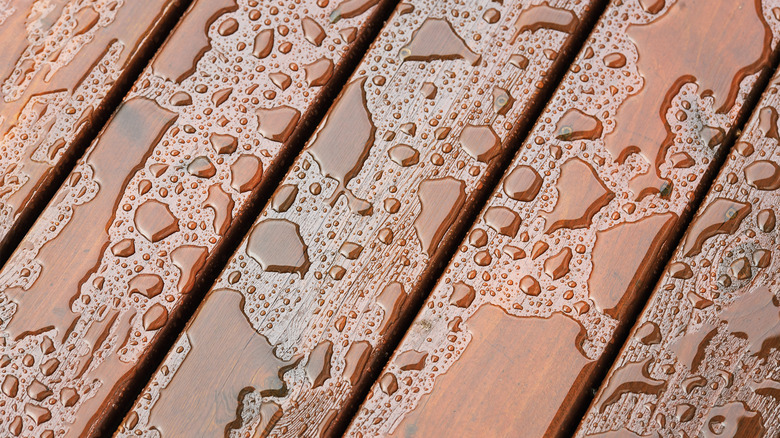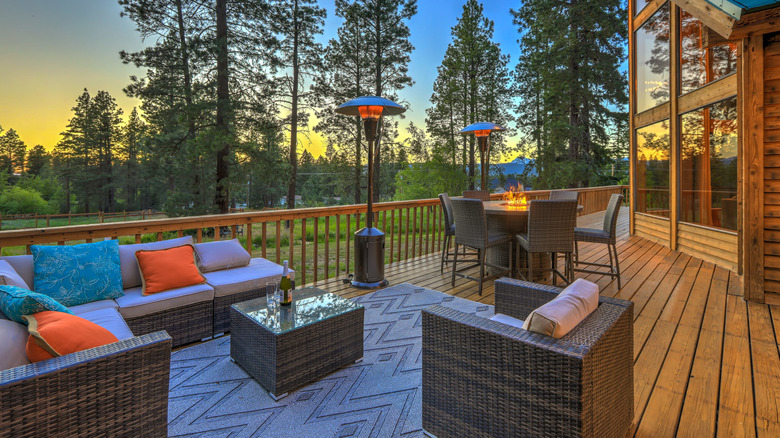Keep Your Deck Safe After Rain With These Non-Slip Hacks
A deck can be a great addition to your home because it not only adds more livable space that can be enjoyed by the whole family but also increases the resale value of your house. However, just like any part of your home that is exposed to the elements year-round, decks require maintenance to ensure they last and are safe. Specifically, the biggest thing you'll need to worry about if you have a deck is keeping it from getting slippery after rain. No one likes stepping outside in the middle of spring to finally enjoy some sunshine after a long winter only to fall flat on their bottom.
Most of the time, the culprit behind a slippery deck is a build-up of moisture which leads to the growth of slimy mold, mildew, moss, or algae. While certain types of deck materials (like composite, cedar, and redwood) are less slippery than others, if you live in a wet climate, sometimes there's nothing you can do to prevent your deck from getting slippery. So, the big question is: what can you do about it?
Keep your deck clear
The first and most important preventative measure you can take to ensure you don't end up wiping out on your deck is to keep it clear of debris. This is essential because if debris like dead leaves, brush, or twigs are left to sit on your deck after a period of rain, they can provide the perfect place for moisture to gather and form a slippery film of mold or moss. So, instead, after every storm, make sure you head outside with a broom to clear away any fallen debris. Just in case, it's also a good idea not to allow any water to pool on your deck. If you notice this happening, you can grab a broom and brush the puddles away to keep your wood dry and mildew-free.
Because of the cold weather and snow, outdoor decks often get less attention in the winter months making this time the perfect opportunity for fungus to build up and spread. For this reason, it is also important to clear any debris before the first snow of the year. If you let debris sit under snow over the winter, you will likely have a mildew problem come spring.
Regularly get rid of moss and mildew
However, no matter how often you clear debris from your deck, if you've experienced a period of wet and cloudy weather, it is still possible for slick fungus to start growing. This is why it is important to regularly check your deck for mold, moss, and mildew. As slippery fungus can be hard to detect, it's also a good idea to scrub down your deck with a soft bristle brush to break up any fungal growth around once every two weeks. For some extra oomph, you can dip your scrub brush in a mixture of water and mild detergent.
If scrubbing is not your style (we don't like working on our hands and knees either which is why we recommend painting your deck the lazy way), then you can get a storebought moss and algae-killing product and simply pour it on problem areas. You can also make a moss-killer by mixing three gallons of water with one quart of bleach and one-third cup of dry laundry detergent.
Furthermore, once a year, it is a good idea to clean your deck with a pressure washer. This will remove any built-up dirt and grime and allow the grain of your wood (which is naturally slip-resistant) to shine through.
Cover your deck in an anti-slip sealant
One of the main reasons why you may be struggling with algae and mold growth on your deck is because there is a problem with your sealant. Deck sealant protects your wood from rain and moisture, so if you don't seal your wood deck (or if it needs to be resealed) you will have more fungus growth and slickness.
Deck sealant comes in many varieties. If you'd like to keep the natural-wood look of your deck, you can go for a stain. However, if you want to try and add a new color that compliments your house, you can choose to paint your deck. But no matter what, when sealing your wood deck, you should always choose a product that is specifically made to be non-slip and long-lasting. Many popular non-slip options have extra added textural elements like sand to help add more traction.
While not the same as sealing your deck, another option that lasts longer but takes more time to apply is decking oil. Decking oil, like wood stain, won't alter the appearance of your deck and it also won't eventually chip and peel off like paint. The downside of this option is that it is on the pricier side.
Add slip-resistant tape or strips
Another option, if you don't want to have to repaint, oil, or stain your deck once every two to three years is to add non-slip strips. These strips are often made of sandpaper-like material and are screwed into your deck to help provide traction even if your deck boards are slightly slick. While some people don't like the look of these strips, they are very effective and can even be purchased in colors that are meant to blend in with your deck.
If you don't like the permanence of non-slip strips, you can go with non-slip tape. This option is great because it is easier to install (it doesn't need to be screwed in), cheaper, and comes in multiple color options from high-vis black and yellow to unobtrusive clear. Non-slip tape or strips are great options if your deck tends to get slippery in specific areas like on the steps or edges.
Decorate with some outdoor rugs and mats
If your deck is only slippery during certain times of the year or if you want something that isn't permanent but can be used as an extra precaution during get-togethers or backyard parties, then buying some non-slip outdoor rugs or rubber mats is a great option. Anti-slip outdoor rugs come in all sizes and designs so you can easily purchase the one that best matches your aesthetic and space.
If you want to temporarily cover a commonly used pathway (like from your back door and across the deck to the yard), then rubber anti-slip mats may be the way to go. The biggest benefit of these mats is that they are weatherproof and can easily be stored when you don't need them and then laid back down when you do. Although rubber mats are typically not the most aesthetically pleasing option, they are inexpensive and effective. Also, if the aesthetics are your biggest sticking point, there are more decorative rubber mat designs out there nowadays.





